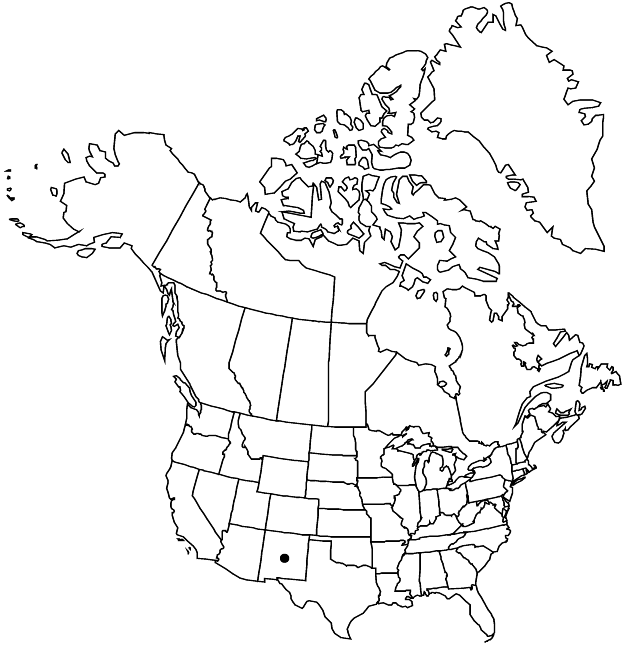Difference between revisions of "Eriogonum gypsophilum"
Contr. U.S. Natl. Herb. 16: 118, plate 49. 1913.
FNA>Volume Importer |
imported>Volume Importer |
||
| (5 intermediate revisions by one other user not shown) | |||
| Line 25: | Line 25: | ||
|distribution=N.Mex. | |distribution=N.Mex. | ||
|discussion=<p>Of conservation concern.</p><!-- | |discussion=<p>Of conservation concern.</p><!-- | ||
| − | --><p>Eriogonum gypsophilum is a federally listed threatened species. It is known only from three locations (Seven River Hills, south of Black River Village, and in the Ben Slaughter Draw/Hay Hollow drainage) in Eddy County. Its relationship to the rest of the species in subg. Eucycla is obscure. It may be more closely related to E. orcuttianum S. Watson, a large shrub of Baja California, Mexico, than to anything in the Rocky Mountain flora.</p> | + | --><p><i>Eriogonum gypsophilum</i> is a federally listed threatened species. It is known only from three locations (Seven River Hills, south of Black River Village, and in the Ben Slaughter Draw/Hay Hollow drainage) in Eddy County. Its relationship to the rest of the species in subg. Eucycla is obscure. It may be more closely related to E. orcuttianum S. Watson, a large shrub of Baja California, Mexico, than to anything in the Rocky Mountain flora.</p> |
|tables= | |tables= | ||
|references= | |references= | ||
| Line 34: | Line 34: | ||
-->{{#Taxon: | -->{{#Taxon: | ||
name=Eriogonum gypsophilum | name=Eriogonum gypsophilum | ||
| − | |||
|authority=Wooton & Standley | |authority=Wooton & Standley | ||
|rank=species | |rank=species | ||
| Line 49: | Line 48: | ||
|publication year=1913 | |publication year=1913 | ||
|special status= | |special status= | ||
| − | |source xml=https:// | + | |source xml=https://bitbucket.org/aafc-mbb/fna-data-curation/src/2e0870ddd59836b60bcf96646a41e87ea5a5943a/coarse_grained_fna_xml/V5/V5_498.xml |
|subfamily=Polygonaceae subfam. Eriogonoideae | |subfamily=Polygonaceae subfam. Eriogonoideae | ||
|genus=Eriogonum | |genus=Eriogonum | ||
Latest revision as of 23:11, 5 November 2020
Herbs, erect, not scapose, 1.2–2 × 1–2 dm, glabrous, green. Stems spreading, without persistent leaf bases, up to 1/8 height of plant; caudex stems matted; aerial flowering stems erect, slender, solid, not fistulose, 0.8–1 dm, glabrous, densely tomentose among leaves. Leaves basal, 1 per node; petiole 3–5 cm, finely strigose; blade cordate to truncate or rarely reniform, (1–)1.5–2.5 × 1.5–2.5(–3) cm, glabrous except for fine hairs on margins and veins, margins plane. Inflorescences cymose, (4–)10–20 × 5–15(–20) cm; branches dichotomous, glabrous; bracts 3, scalelike, triangular, (2–)3–5 mm. Peduncles slender, erect, (0.5–)1–3 cm. Involucres 1 per node, campanulate, 1–1.5 × 2–2.5 mm, glabrous; teeth 5, erect to spreading, 1–1.3 mm. Flowers 1–2 mm; perianth yellow, glabrous except for fine white hairs along midrib; tepals connate proximal 1/3, slightly dimorphic, those of outer whorl lanceolate, 1.3–1.7 mm wide, those of inner whorl narrowly lanceolate, 0.7–0.9 mm wide; stamens exserted, 1.8–2.2 mm; filaments glabrous or nearly so. Achenes light brown, 1.5–2 mm, glabrous. 2n = 40.
Phenology: Flowering May–Sep.
Habitat: Eroded gypsum clay hills and fans, creosote bush communities
Elevation: 900-1100 m
Discussion
Of conservation concern.
Eriogonum gypsophilum is a federally listed threatened species. It is known only from three locations (Seven River Hills, south of Black River Village, and in the Ben Slaughter Draw/Hay Hollow drainage) in Eddy County. Its relationship to the rest of the species in subg. Eucycla is obscure. It may be more closely related to E. orcuttianum S. Watson, a large shrub of Baja California, Mexico, than to anything in the Rocky Mountain flora.
Selected References
None.
